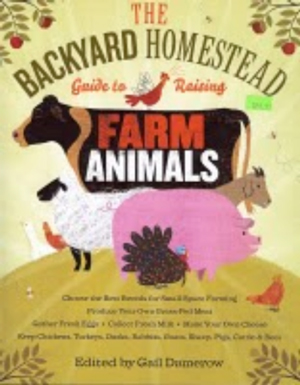Posts Tagged ‘Mini Farm’
Great Summer Read!

Suburban homesteads come in many shapes and sizes, taking their own path to self-sufficiency, but, in my mind, a true homestead needs livestock to be complete. Whether two footed or four; feathered or furred or wooled, animals are what turn a backyard garden into a full fledged farm. Without them all you have is a garden, which is nice, but a homestead is a little more scrappy. It’s loud and it’s dusty and sometimes messy when it’s full of feathers and cloven hooves, paws and fur.
I found a new book for my homestead library recently – The Backyard Homestead’s Guide to Raising Farm Animals.
It’s the livestock companion to the original Backyard Homestead, and it’s a fine introduction to jumping on the livestock bandwagon. At first it may seem a little elementary for the more seasoned livestock person, but it’s perfect for those who have dreams of turning their landscaped suburban lot into a thriving mini-farm, or those who have never held a chick or readied a hutch for kits.
It’s a friendly read, full of easy to understand information about the basics of starting a flock of chickens, ducks, turkey’s or geese; a hutch or two of rabbits; or a herd of goats, sheep or pigs. It even has information about raising cattle on a small suburban homestead. It will give you a good idea of what you’re getting yourself into, along with wonderful plot maps on how to lay out your farm if you’re just getting started.
The illustrations and sidebar instructions are great and each species is broken into its own chapter, so you can read only those parts that interest you. Want goats, but not pigs. Fine. Can’t have bees, but can have chickens. No problem, just read the chapters you want.
Even with my years of livestock experience I’m still able to glean useful information from new sources. It’s becoming a new favorite around here. Grab one for yourself.
Make 2011 the Start of Your Own Suburban Homestead

Forget covered wagons and dusty prairie towns. As we look out over the coming year, unemployment is still at staggering rates, the cost of food still rises and the economic forecast still gives us the jitters. But, it’s not too late to take your life into your own hands and control. Your little suburban lot has more potential than you give it credit for. From growing your own food to raising your own livestock to living a more simple less complicated life, start this new year by taking action to develop your own homestead—right in your own backyard. Along the way, you’ll be building a sustainable, self-reliant and self-sufficient life.
Homesteading intrigued city residence as early as the 1880’s. Decades later city dwellers planted Victory Gardens, raised chickens and made their own clothes to help provide their family’s basic needs. So why not you? Why not now? Why not on your postage-stamp sized lot? Creating a productive “mini farm,” with all the hallmarks of a larger farming operation could be just the action that helps you and your family weather these uncertain times.
While these 10 key elements make up the “perfect” suburban homestead, individual family situations vary greatly and many of these elements can take years to fully implement. Therefore, any suburban homestead should be considered a work in progress, with new elements incorporated periodically to achieve the final goal. Read the rest of the story »
Suburban Homesteading – One, Two, Three
Three Easy Steps To Get You Started – Homesteading In Suburbia
Part One of a Three Part Series
Starting a suburban homestead can be a daunting task, not to mention gleaning through the mounds of information and trying to scale it down to meet the needs of your suburban homestead. With this in mind, Suburban Homesteading – One, Two, Three will lay out the basic steps for turning your suburban home into a productive homestead.
During the homesteading era of the 1800’s, a family’s primary concerns were to provide shelter, warmth, food and water. But for the modern day suburban homesteader, these are either already provided through the home (i.e. heat and water) or easily accessible as in the case of food from a grocery or big-box store. So, homesteading becomes a choice rather than a necessity. Even though you have time to think about what you want to do as a suburban homesteader, there are still practical steps each family should take. And the first step to take is to PLAN.
STEP ONE – Having the Family Discussion
If you’ve been thinking about turning your humble suburban lot into a thriving, productive “mini-farm,” discuss it with your family first…kids included. It’s difficult to homestead alone, and without the family’s “buy-in,” it can be an uphill struggle.
Talk about the kind of homestead you want to have and how self-sufficient you want to become.
The most important step in a successful homestead that doesn’t overwhelm you is “THE PLAN”. Since this is the beginning stage of the plan, dream big and list everything you want to do, be and have. Don’t worry about having enough space or buying the right supplies, there are plenty of people who grow food on apartment balconies or on condo patios.
Reality will set in soon enough – forcing you to scale down your plans and be a bit more realistic. But, for now, the sky’s the limit.
To help get you talking about the possibilities a sampling of questions you and your family will want talk about is below. As you go through this process, more questions may come to mind. Include any of your own questions along with the answers to the list that is provided. This is by no means all the questions that should be asked. They’re provided just to get you thinking.
The answers to some of these questions will depend on the amount of time and effort you want to dedicate, and can dedicate to your homesteading venture.
Be sure to write down your answers so you’ll have them for future steps in the process. Read the rest of the story »

Recent comments
Aenean nonummy hendrerit mauris. Phasellus porta.